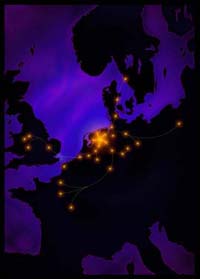 |
|||||||||||||
|
|
HOME → LOFAR → 1.Introduction | ||||||||||||
|
|
|||||||||||||
|
1. Introduction
LOFAR (LOw Frequency ARray, http://www.lofar.org) is a new powerful radio telescope, currently under construction by ASTRON, the Netherlands Foundation for Research in Astronomy. Its purpose is to operate between 10 MHz and 240 Mhz, a largely unexplored frequency range. It will allow to observe the Universe in its initial evolutionary stage, to study radio sources in a rather unexplored window offering the possibility to make new extraordinary discoveries. LOFAR will be the first new generation radio telescope, composed by a great number of small and inexpensive antennas. The technological and structural LOFAR basic concepts represent a breaking point with the past and their practical evidence is constituted by a considerable reduction of costs: this has been made possible disregarding the traditional parabolic antennas. LOFAR antennas will be without any moving mechanical part, so they will be more reliable and simpler to build and maintain. Fig. 1.1 : LOFAR Antennas The signal received by these small and low-cost antennas is immediately digitized and sent through new and broadband links to a super-computer (IBM BlueGene/L) capable to synthetize radio images in real time. The particular antenna design, together with the array concept properties, will allow to have multiple fields of view, namely the possibility to point various directions simultaneously: it will be possible to move the antenna beam in few micro seconds. Moreover, thanks to the adaptive beamforming techniques, it will be possible to suppress radio frequency interferences (RFI) that represent a big problem at these frequencies.
|
|||||||||||||
|
G. Bianchi |
|||||||||||||

